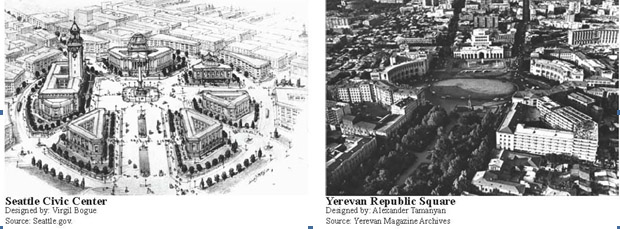
A Beautiful City Creates Beautiful Residents
By Vrej Haroutounian
Important as beauty was for itself, its role in environmental conditioning was never far from the minds of civic center advocates. The civic center's beauty would reflect the souls of the city's inhabitants, inducing order, calm, and propriety therein. Second, the citizen's presence in the center, together with other citizens, would strengthen pride in the city and awaken a sense of community with fellow urban dwellers.
Wilson, William1989
We often hear people say that Yerevan is a beautiful city, they could not be more right. The City Beautiful movement in its time was motivated by a new set of ideals that drew their influence from European cities and approached urban planning from a new perspective. Once again, these Western ideals found their way into the urban planning of Yerevan. Understanding the principles of the City Beautiful movement helps to further explain its influences in the civic design of Yerevan.
The politicization of urban design is best reflected in the City Beautiful movement that was popular from the early period of the 20th century until the beginning of the Great Depression (Carlino, 2008). The goal of urban planners was to influence the heart, mind and purpose of the citizens, through the beautification of the urban landscape. Government and public buildings would stand in direct relation to each other, connected by clean, beautiful, paved streets, and featuring high-quality site furnishings and well-maintained and controlled street trees. The idea was to imbue urban dwellers with civic patriotism, encouraging them to be better-disposed towards community needs by providing them with a beautiful, well-arranged city that combined the aesthetics of English garden landscape design with neoclassical building design (Wilson, 1989).

Seattle Civic Center and Yerevan Republic Square
The architecture of the City Beautiful movement was almost always neoclassical, a trend that prompted much criticism(Wilson, 1989). The movement was, in principle, a social engineering solution hoping to improve civic society through the creation of a beautiful urban landscape (Carlino, 2008).
In a broader sense,the City Beautiful movement was political, as it demanded a reorientation of public thought and action towards urban beauty. The environmental reorganization necessary for the movement required an altered political structure, including state-enabling legislation, new public institutions such as park boards, and grants of power to private entities to build railroad stations and other semi-public buildings. The political dimensions of City Beautiful went beyond structure and process to the elements underlying much of surface change– citizen agitation and activism (Wilson, 1989).
The University of Paris, L’Ecole de Beaux Arts, the leading university of the period between the 1870s and the 1930s, was training architects in the concept of urban design based on the principles that a better-designed city would promote economic growth, higher efficiency and more engaged citizens. The redesign of Paris by George Haussmann popularized the City Beautiful ideology (Klein, 2011). The 1893 Chicago World’s Fair, designed by architect Daniel Burnham as a model for the ideal city, was a great success in promoting the design principles of the movement (Klein, 2011).
In 1902, the McMillan Plan was introduced to redesign the mall area of Washington D.C. for its 100th anniversary. Prominent architects of the time, including DanielBurnham, Frederick Law Olmsted, and Charles McKim, were hired to design a plan that would mirror classic architectural design in a park-like setting. The success and popularity of the City Beautiful movement led to its implementation in urban designthroughout cities inthe United States and abroad.
The ideology, roots and intent of the City Beautiful movement explain how it would later be implemented in the design of Yerevan. This movement appealed to the Communist Party, as did the principles of the Garden City movement. The goal of the Communist Party was in line with the planners of the City Beautiful movement– to influence the hearts, minds, and purpose of the citizens, through the beautification of the urban landscape. These conceptsof the Garden City and City Beautiful movements arrived in Yerevan, by way of Russia. Once again,the force of globalization was demonstrated in an urban planning idea that traveled across the globe to be implemented within a short time period in Yerevan. The followingarticle explains how changes in political ideology can limit developments in certain types of urban planning, while promoting changes that are more suitable to realities, wants, and socio-economic conditions of the day. The influence of the City Beautiful movement are evident most clearly evident by the Republic square and the strong axis of parks and streets that connect it to other parts of the city.
Sources:
Carlino, G.A. and Saiz, A. (December 6, 2008). Beautiful city: Leisure amenities and urban growth. Federal Reserve Bank of Philadelphia Working Paper No. 08-22.
Retrieved from: http://ssrn.com/abstract=1280157 or http://dx.doi.org/10.2139/ssrn.1280157.
Klein, R. (2011, July 1). An overview of the city beautiful movement as reflected in Daniel Burnham’s vision. Retrieved from http://academic.csuohio.edu/tah/regional_arts/.../p61anoverview.pdf.
Wilson, W.H. (1989). The city beautiful movement. Baltimore: Johns Hopkins UP.
 Videos
Videos Photos
Photos




Write a comment